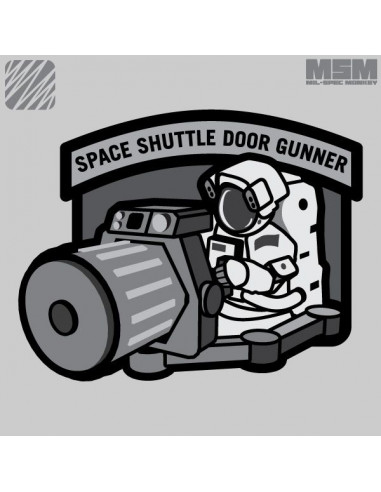[Source for the Art](The source for the art: https://twitter.com/konwashi_2/status/1849000087248376017?s=46)
Gunpowder is self oxidizing when ignited. As long as they used a non-evaporating lubricant on the actual mechanical components like graphite, and included a barrel liquid cooling loop, the M2 would operate totally fine in space.
Now I want to see a space-ready heavy machine gun with a big radiator attached
A closed loop wouldn’t work probably. You’d need an open loop, or a shit ton of radiators. I guess potentially it could couple to the ground and sink heat into it, but you’d need to be stationary.
See also Brigador: apart from the various lasers, exotic ballistics, and nightmarish chemical weapons it includes, there’s also the prosaic “Mãe Dois.” The tech entry leaves no doubt about what it is:
You have the Heavy Stubber in 40 k too!
Brigador has such a cool aestetic
The year is 2734. Humanity has conquered death, cured every disease (even the common cold), and colonized the stars. Yet on battlefields from Earth to Europa, the M2 Browning still thunders, the BUFF rumbles through alien skies, the M1 Abrams fires its 120mm cannon, and every Marine is issued a KA-BAR.
reminds me of the best patch I’ve seen in a long time - Shuttle Door Gunner

So… I don’t see that anyone’s brought this up yet so here goes:
If we are talking space space, you know, in orbit, transiting between planets…
You have to account for the recoil of each shot potentially sending your craft into a rotational spin, which can alter its trajectory.
Depending on the mass of your firing platform, you may have to expend a considerable amount of monoprop fuel, or energy in batteries to run multi axis centrifugal stabilizers…so that you maintain your desired trajectory.
Also, even if you are not in space, but on a moon or planet with significantly lower mass than earth… you’re gonna have to do extra work to keep your tripod from dislodging from the ground, even knocking you backward with a sustained burst.
It might not even be practical to do a sustained burst or sweep, it might end up making sense to mod a slower cyclic rate into the thing, jerry rig a Kriss Vector counter weight style contraption to lower recoil.
Basically, the weight of everything involved goes down as G goes down… but the recoil energy remains the same… if you are in 0.5 G, basically, the recoil is twice as intense, as its pushing against half as much weight.
Each single shot would be more precise and travel farther in a vacuum or thin atmosphere and lower G… but sustained fire would be less accurate.
…Or maybe I’m overstating this effect? I’m too tired and lazy to attempt the actual physics calculations for recoil force.
All these problems are solved by firing two M2’s in opposite directions, a net positive for everyone involved.
Well that is insanely stupid, but it would net the recoil out to 0, if they are perfectly aligned…
Brilliant!
I like this idea better than the recoilless rifle conversion I was thinking about.
Gyrojet ammunition has entered the chat.
The space shuttles were originally designed with 6 M2s mounted in the wings. It was mostly a tradition thing, but they cut the armament to save weight or something stupid. Fast forward to the Columbia disaster, and where does the fatal foam piece strike? Right in the firing line of old ma deuce.






